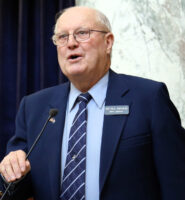Idaho school districts and charter schools stashed more than $250 million in 2016.
The unspent money, up roughly $35 million from 2015, resides in fund balances, or district savings accounts.
On average, these funds constituted 28 percent of annual operating revenues in 2016. But like many averages, this number tells only part of the story.
Four school districts and one charter school stashed enough cash to match their entire operating budgets in 2016, according to State Department of Education numbers. And three districts tallied savings that may conflict with Idaho law.
Meanwhile, a majority of the state’s biggest savers still asked voters to approve supplemental levies in 2016.
But not everyone stashed away extra cash. One school district and five charter schools operated in the red, and 24 others operated with savings representing less than 10 percent of their annual budgets.
The uptick in savings, and the statewide disparity, has some lawmakers and educators questioning how much districts and charters should keep on hand, and whether districts with large reserves should ask their patrons for supplemental levies.
What was — and wasn’t — saved
In all, 154 of the state’s 165 districts and charters carried fund balances in 2016 — up from 149 in 2015.
Nine carried fund balances of at least 80 percent of their annual operating budgets:
- Salmon River: 114 percent ($1.5 million).
- Kootenai: 107 percent ($1.6 million).
- Avery: 103 percent ($294,250).
- Pleasant Valley Elementary: 103 percent ($222,103).
- McCall-Donnelly: 100 percent ($5.9 million).
- Kootenai Bridge Academy: 89 percent ($1.3 million).
- Murtaugh: 83 percent ($1.5 million).
- Mackay: 83 percent ($1.3 million).
- Mountain View: 80 percent ($5.9 million).
On the other end of the spectrum, eight districts and charters operated in the red or without any savings:
- Blackfoot Charter Community Learning Center: -9 percent (-$196,455).
- The Village Charter School: -9 percent (-$140,778).
- Bingham Academy Charter: -7 percent (-$50,488).
- Blackfoot: -5 percent (-$926,568).
- Idaho Science and Technology Charter School: -2.2 percent (-$41,157).
- INSPIRE Connections Academy: -1 percent (-$39,213).
- Chief Taghee Elementary Academy: 0 percent ($0.00).
- Idaho Virtual Academy: 0 percent ($0.00).
(Click here to see how much your district or charter saved.)
Should districts with big savings accounts ask for supplemental levies?
Eight charter schools and 18 school districts carried fund balances of at least half of their annual operating budgets in 2016. Of these school districts, 12 passed supplemental levies.
The Salmon River School District, the state’s top saver, asked patrons to renew its one-year, $525,000 levy in May, despite carrying a fund balance 14 percent larger than its annual operating budget of $1.3 million.
In a Facebook post before the election, the district stated that Idaho “continues to under fund [sic] education,” and said a no-vote on the levy would force administrators to “make even more difficult cuts that will drastically affect our quality of education, our students, our staff, our facilities and our community.”

The levy passed. But patron and state Rep. Paul Shepherd said the district’s rhetoric heading into the election hardly reflected its financial standing.
“The message that we got was that if we didn’t pass the levy the district would face several cuts,” said Shepherd, R-Riggins. “You would’ve thought they were destitute.”
Salmon River business manager Michelle Hollon acknowledged the tax burden supplemental levies place on patrons, but said districts such as timber-rich Salmon River require large savings accounts because they rely heavily on unreliable federal funds.
“There is no guarantee that we will continue to get federal forest funds,” said Hollon, adding that districts in timber country lack tax bases comparable to those in more developed parts of the state.
Forest funds, as provided by the federal government’s Secure Rural Schools program, have proven to be anything but secure. The 2000 law was designed to provide a funding stopgap for communities in timber country by replacing the money counties and school districts used to receive from timber sales on federal lands. But Congress stopped its funding in 2016-17.
As a result, Idaho schools received $659,000 in 2016-17, roughly a tenth of the money that came in 2015-16. (Click here to see what your district received in 2015-16 and 2016-17.)
Shepherd acknowledged the difficulties of drumming up local cash in timber-rich districts, but said Salmon River should have been clearer about its reserves.
“My wife and I feel the pinch from these taxes,” Shepherd said. “We live on seven acres of riverfront property.”
Does Idaho law cap savings accounts?
Federal forest funds enabled the state’s top five savers to carry fund balances larger than their annual budgets in 2016. But three districts — Kootenai, Avery and Pleasant Valley Elementary — carried savings larger than their annual budgets sans federal subsidies, which may conflict with Idaho law.
The law states that the “balance of said fund shall not be accumulated beyond the budgeted fiscal year.”
SDE spokesman Jeff Church said this sentence is to be read in larger context of the law.

“(The) next sentence continues with, ‘If any money remains in the contingency reserve, it shall be treated as an item of income in the following year’s budget’,” Church said. “The balance (contingency reserve) for the budgeted fiscal year must be treated as income in the following fiscal year, rather than the balance being treated again as the contingency reserve in the following fiscal year.”
Idaho law does not prohibit operating with a deficit, though doing so can hamper a district’s bond rating, which can affect its ability to secure bond issues for building and maintaining infrastructure.
After two years of operating in the red, the Blackfoot School District’s bond rating has slipped from a “Ba1 to a “Baa3.”
Though the district’s bond outlook status is still considered “stable,” Blackfoot superintendent Brian Kress said the deficit is the result of a perfect storm: years of recessionary cuts mingled with declining enrollment.
In 2013, 4,290 students enrolled in the district. That number fell to 4,069 in 2014 and 3,922 in 2015. The growing popularity of nearby charter schools contributed to this trend, Kress said. (Idaho’s funding formula allocates money to districts based in part on average daily attendance.)
Though Kress lamented the lingering deficit, he pointed to recent improvements. The district eliminated 33 percent of its debt in 2016, which Kress attributes to more conservative enrollment projections.
“We actually plan for decreases in enrollment now, which is helping us slowly minimize the deficit,” Kress said.
Idaho Education News data analyst Randy Schrader compiled data for this story.
